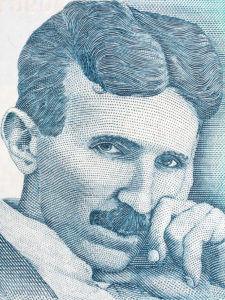Thinking into the Future: Conversation with Futurist Gray Scott
Futurist and techno-philosopher Gray Scott shares how he thinks about the future.
By Stephen Dupont, APR
Welcome to the future!
Or futures, actually.
I was recently introduced to futurist and techno-philosopher Gray Scott by the World Future Society, which recommended Gray for an article I was writing for PRSA’s Strategies & Tactics magazine. I found the conversation so fascinating that I asked Gray if I could do a follow-up interview, which would allow me to go more in depth on several questions. He graciously accepted and the result is the following Q&A.
Regardless of what you do as far as a career is concerned, how old you are, your gender, etc. – please read through this entire article. Why? Because we all need to start thinking about the future. Not just marketing executives. But truck drivers, nurses, and fast-food workers. We all need to become more comfortable with change. The amount of change occurring all around us right now is simply mind-boggling. But more worrisome — many of us are not prepared to deal with what’s ahead – what we know is coming (such as driverless cars) and what we may not be prepared for (I’ll leave this to your imagination). Gray Scott helps to shed light on what’s next, and shares some thoughts about how we can embrace change.
Stephen Dupont: When you look back at your childhood, was there something you did, or something that happened to you, that connects with your identity as a futurist today? For example, did you participate in a robotics program at school, or did you read a certain book/watch a movie that inspired you?
 Gray Scott: When I was about 10 years old, I started taking private art classes. My teacher taught me how to paint with oils. The experience made me think that I’d like to be a painter one day.
Gray Scott: When I was about 10 years old, I started taking private art classes. My teacher taught me how to paint with oils. The experience made me think that I’d like to be a painter one day.
One day, she asked me and the other students to close our eyes and envision a landscape. A brook, the sun, the clouds. Then, she asked us to move the clouds in our minds and see, how the sunshine affected the land and the water.
I had never had someone guide me through a visualization such as that. That’s when I realized that if you can see something in your mind, you can make it happen.
Later, in reading about the inventor Nikola Tesla, who described the same process of visualization that he used to see new inventions in his head, I realized that I was becoming a futurist. What struck me about Tesla was this additional thought: It’s not just seeing a vision, but it’s controlling that visualization in your mind.

Stephen Dupont: Could you describe the path that you took to become a futurist? Can you point to any specific experiences that helped define your mindset?
Gray Scott: Well, before I became a full-time futurist I was a professional commercial photographer. But, in 2009, with the Great Recession, my business dried up. So I decided to take a year off and travel a bit. I traveled to places such as Egypt and Peru.
While I was traveling I felt this tapping on my shoulder. Maybe it was more like a nudge. It said, “Go explore futurism.”
Stephen Dupont: You’re a member of the World Future Society. How has that organization influenced your journey as a futurist?
Gray Scott: As I kept feeling this nudge, I started to Google all things about futurism, as you can imagine. And that’s when an ad popped up about the World Future Society’s international conference in Toronto. It looked interesting. I signed up to take a futures writing course at the conference. There were about 2,000 people there and as soon as I walked into the conference I just knew that I was meant to be there. There were people from every walk of life. They all came from different parts of society and did different types of work. But it was how that they thought. That’s when I knew these were my people. I was inspired by it all and knew then that I was on the right path. And I haven’t looked back since.
Stephen Dupont: How did your experience as a photographer influence your ability to think as a futurist?
Gray Scott: I think it goes back to visualization – and the need to hold something in your brain. As a photographer, I would get a creative vision in my head for a specific photographic expression and then use photography to express that image. By practicing it over and over, it became instinctual. As a futurist, I take that concept further. For example, if I think about a future of living on Mars, in my mind, I can inhabit that idea. I can control it and shape it.
Stephen Dupont: And then you can express it?
Gray Scott: Yes, through my writing, or the videos I create for Futuristic Now, or as a consultant to TV and movie producers or corporate clients.
Stephen Dupont: How far into the future do you think?
Gray Scott: I’m often asked this question. To me, it’s about long-range thinking. Generally up to 50 years. I help my clients, often organizations, think about possible futures and what their role might be in it. As I’m visualizing, the further you go out, the more pixelated things get. I look for small things and big things in the future. And I pose questions that might have an impact on those futures, such as:
“When will we have the capability to live on Mars or the Moon?”
“When will we have the ability to go anywhere we want in the Universe?”
“What happens to our future if our planet gets hit by an asteroid?”
“What happens to our future if a nuclear war occurs?”
“What if a pill is invented that dramatically extends life?”
Stephen Dupont: Are there any specific thinkers, futurists, authors, etc., who have influenced your thinking?
Gray Scott: Yes, there are a number of writers and thinkers that have influenced me and whom I’d recommend for those who want to learn more about how the future or future trends. FM-2030 (who was born Fereidoun M. Esfandiary) is a great place to start. He was an extreme futurist.
Alan Watts blended Buddhism into this thinking, giving me a better sense of balance to my forecasts for the future.
I would also recommend: Terence McKenna, Arthur C. Clarke, Alvin Toffler, Kevin Kelly, and Carl Sagan.
Stephen Dupont: What about movies that you would recommend for someone who wants to develop a futurist mindset?

Gray Scott: I would recommend 2001: A Space Odyssey. I’ve seen that movie many times. But it had a profound affect on me after I decided to commit myself to my new path of becoming a professional futurist. A thought struck me while watching it: I realized that when the monkey touches the monolith, it’s a metaphor for what’s happening to us now – the digital world that we’re being introduced to through devices such as the iPhone.
This begs the question: “What makes it into the future?”
What I’ve come to realize is that we are much bigger than what we think we are. And this is where we move from futurism to more cosmic thinking. We need to understand that our DNA is connected to the DNA of the monkey millions of years ago, and it’s connected to another civilization light years away. In other words, we don’t exist in a vacuum. The movie 2001 helped me realize that the constructs of the now are ready to fade. And within all of this is the vary nature of the mystery of the cosmos itself.
Going back to your question, I’d also suggest watching movies such as Her, Ex Machina and Contact.
Stephen Dupont: There are many movies such as Terminator, Divergent, The Matrix, or the Hunger Games, that portray a dystopian future. Do you foresee a dystopian future for us?
Gray Scott: I think we need to be very careful of movies such as those. Remember, drama and fear sells tickets. Buddhism has influenced my thinking about the future. I see a constant back and forth between creation and destruction, between light and darkness.
I don’t think we can create a utopia. On the other hand, it’s hard to create a dystopia, too.
Like today, in the present moment, I think we will see pockets of bright futures and places that are experiencing dystopian-like situations.
Keep this in mind: We all will experience the future differently. A person in Ohio will experience a different future than someone in Saudi Arabia.
Stephen Dupont: When you consult with businesses and other groups, what do they most want to know? Do you find that most people just want predictions instead of learning how to think about the future?
Gray Scott: When I’m working with a corporate client, they typically are looking for a forecast, as well as how I arrived at my specific forecast for them. In other words, they want to know how I think. Often these assignments involve questions such as: “What is the future of food?” or “What is the future for airplanes?”
Using visualization, what I try to do is help these clients think in detail. So it’s not just what the outside of an airplane will look like in the future, but what the inside will look like, too. For example, in the future, we may have windowless airplanes because with micro LCD technology, we could make the entire inside of the plane look like the outside – as though you were riding on the air. Besides, we need to keep this reality in mind — engineers are looking for ways to cut costs. So, having windowless planes would not only cut costs in the manufacturing of those planes, but also in a plane’s weight and its maintenance.
Here’s an important point: If I offer a forecast or a visualization, I always offer a “why” to help people understand my thinking.
Stephen Dupont: What does it mean to have a futurist mindset? How can someone develop a futurist mindset?
Gray Scott: I think the first step is learning how to visualize – to see the kind of future you want. To see multiple futures. The key is to do so at the granular level.
Imagine that you’re walking down a street in the year 2040. What do the houses look like. What color is the grass (is there grass)? Describe how the streets look and what they’re made of. The air – what it smells like. The sky – what’s in it? Once you start visualizing like this for even a few minutes you begin to feel the future. And more importantly, you start to rewire your brain to the point where it becomes second nature.
Second, you need to know your history. I think you need to know where we’ve come from so far, but also, what other futurists have already envisioned and forecasted. By doing so, you learn how other futurists think.
Third, it’s critical that you pay attention to emerging technology. Here’s a word of caution – by the time a product arrives at the annual Consumer Electronics Show (CES), the technology behind that product is often 10 years old or older. Instead, you need to dig deeper. You need to look for studies and stories about research that may lead to new technologies. For example, I recently read about a team of research scientists who are working on deep neural networks who were able to capture a visual of a person thinking about a memory. So, imagine that for a moment and what the implications would be if you could capture visuals, like a 3D-video of memories.
Fourth, you need to practice your craft – just like anything else. You need to write about it. Live it full-time. Every conversation I have is about the future.
Stephen Dupont: Why do you think it’s important to develop the mindset of a futurist?
Gray Scott: I think the main reason is you don’t want the future to arrive and you’re not prepared.
Let me explain. Take someone from the year 900 and drop them into a Mars Colony in the year 2040. You would agree that person would absolutely not be prepared to deal with that experience. Right?
Well, that kind of unimaginable change is not that far off in our existing future. Many people are ignoring what’s right in front of them. When they do take time to think about it, you see it on their faces. They’re shocked by what’s next.

I also think we have a moral responsibility to future generations to prepare them for what’s coming. Imagine, if you will, the first human biting into a strawberry. Now, keep in mind, in nature, the color red is often associated with danger. So, when that person bit into the strawberry, he or she didn’t know if it would kill them or not. They took a chance, in other words. And all of those small chances that have been taken over centuries have allowed us to be here today.
So imagine these “first” things or moments that today’s humans will need to take a “chance” on so that we can move forward:
— The first human to have sex with a robot with AI (like in the movie Ex Machina) or the person who wants to marry their android.
— The first baby born using an artificial uterus.
— The first human to clone themselves.
— The first baby born on Mars.
— The first human to leave our solar system.
— The first person to make “real” contact with a being from another world.

Stephen Dupont: Gray, you are an advisor to the Lifeboat Foundation, a nonprofit, nongovernemtnal organization dedicated to encouraging scientific advancements while helping humanity survive existential risks, and the possible misuse of increasingly powerful technologies, including genetic engineering, nanotechnology, and robotics/AI as we move towards the Singularity. As technology does become more powerful and more mainstream (e.g., designer babies), do you think the greatest hurdle that we will need to deal with is the challenge to our ethics and values? For example, scientists just cloned monkeys. What if we started to clone people, such as in Star Wars, for specific purposes – such as doing the jobs that everyone hates?
Gray Scott: We may see clones as well as robotic work force in the future.
Stephen Dupont: In my interview with World Future Society president Julie Friedman-Steele, she said that futurists see multiple futures and that futurists must always advocate for positive futures. Do you agree with that?
Gray Scott: I take a slightly different approach to this question. Thinking about being here in the present, it is a miracle to be here now and where we are now, and it’s this realization that allows us to deal with change. Change, after all, is a cosmic rule.
However, we need to realize that most people are afraid of change and that’s because they don’t trust themselves. And yet, deep experience is found in change. Change defines who we are today and what we might become.
As we look at multiple futures, which are constantly changing, we all must place greater trust in ourselves and each other. So, even if a nuclear war were to occur, we trust in ourselves enough to know that we will adapt to that change.
Stephen Dupont: There are many changes coming — from robots/androids in the workplace to driverless vehicles to artificial intelligence. What major changes do you see within the next 10 years?
Gray Scott: Here are some of the major changes I see coming:
Artificial Intelligence (AI) – It will become ubiquitous throughout our society. When one AI system can start teaching other AI systems that will become a profound moment that will change the world. It will be difficult for many people to realizing and grasp that their skills or talents are no longer needed because artificial intelligence can do them better.
The price of things will become much cheaper as we turn over the production of products to robots and artificial intelligence.
Social constructs will change. For example, as more and more driverless cars and trucks enter our system, there may come a day when it’s not safe for humans to drive and we need to pass laws that ban people from driving in certain places of our country. Can you imagine that debate?
Hand-crafted items made with human hands will become a luxury. As people are not needed to do jobs that robots and AI systems do, they will turn their attention to making things with their hands. Many people will do this because they really want to do it. I think we will see a mass migration of people actually doing their dream jobs.
We are not alone. I believe there are other civilizations across the universe. But keep this in mind, if aliens do decide to announce themselves to us, these beings will be highly advanced. Maybe a million years more advanced than us. Why? They would have to be to have figured out how to travel the vast distances – the millions of miles – across the universe to get to Earth.
Stephen Dupont: In our first interview, you spoke to the importance of empathy — that humans need to develop their ability to empathize with others if we’re going to have a future as a human race. Could you explain that in more detail for me?
Gray Scott: Technology is a reflection of humanity and the cosmos. We should be sure we create machines that have empathy for other living beings if we want a peaceful future.
Stephen Dupont: Thank you Gray for sharing your thoughts.
Gray Scott: You’re welcome.
Stephen Dupont, APR, is VP of Public Relations and Branded Content for Pocket Hercules (www.pockethercules.com), a branding and creative firm based in Minneapolis. Contact Stephen Dupont at [email protected] or visit his blog at www.stephendupont.co.